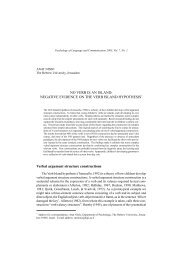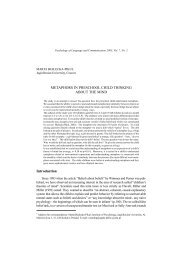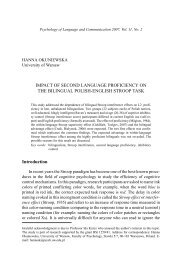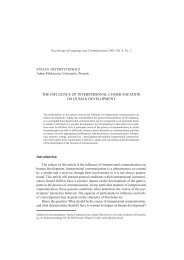The effecTs of groUP coNscioUsNess oN JAPANese lANgUAge ...
The effecTs of groUP coNscioUsNess oN JAPANese lANgUAge ...
The effecTs of groUP coNscioUsNess oN JAPANese lANgUAge ...
Create successful ePaper yourself
Turn your PDF publications into a flip-book with our unique Google optimized e-Paper software.
82 Norie Mogi<br />
A number <strong>of</strong> studies <strong>of</strong> the Japanese language and Japanese people’s language behavior<br />
have been carried out (Nakane, 1970, 1976 & 1978; Suzuki, 1973 & 1975; Kindaichi,<br />
1975, 1988 & 1991; Higa, 1976: Tsurumi, 1976; Shibata, 1976 & 1977; Kunihiro, 1977;<br />
Mizutani & Mizutani, 1977; Mizutani, 1979; Befu, 1980; Morita, 1995 & 1998). Benedict<br />
(1946) described the traditional image <strong>of</strong> Japanese people in “<strong>The</strong> Chrysanthemum and<br />
<strong>The</strong> Sword”, which then became the stereotype in the West. Yamagishi (2000) claims that<br />
Asians act in a collectivist way, unlike their Western counterparts. Laungani (2000) argues<br />
that identity in Western cultures is represented in individualistic terms, whereas collective<br />
terms are <strong>of</strong>ten used for identity in the non-Western cultures . Befu (1980) refers to the<br />
Japanese society as a group model. Group consciousness as a sign <strong>of</strong> social identity is one<br />
<strong>of</strong> the striking features <strong>of</strong> Japanese people although it could be understood as a stereotype<br />
(Maynard, 1997, p. 30). <strong>The</strong>se are labeled by the outsiders, but how the Japanese consider<br />
themselves is as follows:<br />
<strong>The</strong> Japanese nation was believed to consist <strong>of</strong> only one pure ethnic group, ignoring<br />
the fact that Chinese, Korean, and Ainu people lived in Japan. This false belief was widely<br />
accepted, and even the ex-Prime Minister Nakasone proclaimed that Japan consisted <strong>of</strong><br />
only one ethnic group, because this belief let the Japanese feel unique and superior to<br />
other groups. In other words, the Japanese would be willing to listen to such an opinion.<br />
<strong>The</strong> notion <strong>of</strong> political correctness has since influenced Japan and the false belief has been<br />
eliminated, nevertheless, it has encouraged the Japanese to develop group consciousness.<br />
It appears that group consciousness is a key issue amongst the Japanese. <strong>The</strong>refore, this<br />
article will be devoted to how group consciousness influences the Japanese language and<br />
people’s behavior.<br />
Group consciousness<br />
Another example <strong>of</strong> the false belief 1 is hito no ki o sassuru 2 , “understanding someone’s<br />
feeling or thoughts without being told”. That is to say, the Japanese were one ethnic group;<br />
therefore, although a speaker did not say everything that s/he would like to tell the hearer,<br />
the hearer could understand what the speaker would like to say. <strong>The</strong> idea has become the<br />
key <strong>of</strong> social interaction. Also, people criticize others for sonna koto mo iwanakereba<br />
wakaranai, “telling even such things which normally must be understand without being<br />
said.” Consequently, the Japanese in general do not like to speak as much as the Westerners<br />
3 , which can be illustrated by the proverb, kiji mo nakazuba utare mai 4 , “if a peacock<br />
did not cry, it would not have been shot”. As a result, people observe others and guess what<br />
others think and expect them to do. Also, the Japanese sometimes care too much about<br />
other people’s feelings; thus, they tend to avoid having an argument by saying something<br />
directly. This would not cause any problem if the Japanese language were used only by<br />
Japanese people; nonetheless, there are more and more non-native Japanese speakers who<br />
communicate in the Japanese language with the Japanese.<br />
1<br />
<strong>The</strong> Japanese nation was only one pure ethnic group.<br />
2<br />
<strong>The</strong> transcription <strong>of</strong> Japanese into Roman script (romanization) used in this article is based on the Hepburn<br />
style. When the same vowel occurs consecutively, the letter is repeated.<br />
3<br />
This depends on situation and people but this phenomenon is <strong>of</strong>ten found in <strong>of</strong>ficial settings.<br />
4<br />
<strong>The</strong>re is safety in silence.








